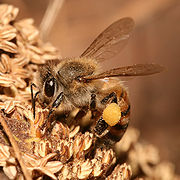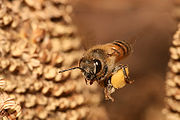
Forage (honeybee)
Encyclopedia


Bee
Bees are flying insects closely related to wasps and ants, and are known for their role in pollination and for producing honey and beeswax. Bees are a monophyletic lineage within the superfamily Apoidea, presently classified by the unranked taxon name Anthophila...
s, their forage or food supply consists of nectar and pollen
Pollen
Pollen is a fine to coarse powder containing the microgametophytes of seed plants, which produce the male gametes . Pollen grains have a hard coat that protects the sperm cells during the process of their movement from the stamens to the pistil of flowering plants or from the male cone to the...
from blooming
Flower
A flower, sometimes known as a bloom or blossom, is the reproductive structure found in flowering plants . The biological function of a flower is to effect reproduction, usually by providing a mechanism for the union of sperm with eggs...
plant
Plant
Plants are living organisms belonging to the kingdom Plantae. Precise definitions of the kingdom vary, but as the term is used here, plants include familiar organisms such as trees, flowers, herbs, bushes, grasses, vines, ferns, mosses, and green algae. The group is also called green plants or...
s within flight range. The forage sources for honey bees are an important consideration for beekeeper
Beekeeper
A beekeeper is a person who keeps honey bees for the purposes of securing commodities such as honey, beeswax, pollen, royal jelly; pollinating fruits and vegetables; raising queens and bees for sale to other farmers; and/or for purposes satisfying natural scientific curiosity...
s. In order to determine where to locate hives for maximum honey
Honey
Honey is a sweet food made by bees using nectar from flowers. The variety produced by honey bees is the one most commonly referred to and is the type of honey collected by beekeepers and consumed by humans...
production and brood
Brood (honeybee)
In entomology, the term brood is used to refer to the embryo or egg, the larva and the pupa stages in the life of holometabolous insects. The brood of honey bees develops within a bee hive. In man-made, removable frame hives, such as Langstroth hives, each frame which is mainly brood is called a...
one must consider the off-season. If there are no honey flows the bees may have to be fed. Bees that are used for pollination are usually fed in the holding yards. Forage is also significant for pollination management
Pollination management
Pollination Management is the label for horticultural practices that accomplish or enhance pollination of a crop, to improve yield or quality, by understanding of the particular crop's pollination needs, and by knowledgeable management of pollenizers, pollinators, and pollination...
with other bee species.
Nectar contains sugar
Sugar
Sugar is a class of edible crystalline carbohydrates, mainly sucrose, lactose, and fructose, characterized by a sweet flavor.Sucrose in its refined form primarily comes from sugar cane and sugar beet...
s that are the primary source of energy for the bees' wing muscle
Muscle
Muscle is a contractile tissue of animals and is derived from the mesodermal layer of embryonic germ cells. Muscle cells contain contractile filaments that move past each other and change the size of the cell. They are classified as skeletal, cardiac, or smooth muscles. Their function is to...
s and for heat for honey bee colonies for winter. Pollen provides the protein
Protein
Proteins are biochemical compounds consisting of one or more polypeptides typically folded into a globular or fibrous form, facilitating a biological function. A polypeptide is a single linear polymer chain of amino acids bonded together by peptide bonds between the carboxyl and amino groups of...
and trace minerals that are mostly fed to the brood in order to replace bees lost in the normal course of life cycle and colony activity.
As a rule of thumb the foraging area around a beehive
Beehive (beekeeping)
A beehive is an enclosed structure in which some honey bee species of the subgenus Apis live and raise their young. Natural beehives are naturally occurring structures occupied by honeybee colonies, while domesticated honeybees live in man-made beehives, often in an apiary. These man-made...
extends for two miles (3 km), although bees have been observed foraging twice and three times this distance from the hive. Foraging at extreme distances wears out the wings of individual bees, reduces the life expectancy of foraging bees and therefore the efficiency of the colony.
The minimum temperature for active honeybee foraging is approximately 55 °F (13 °C). Full foraging activity is not achieved until the temperature rises to 66 °F (19 °C). There are small differences in the races of the Western honey bees at what temperature they will start foraging.
The main nectar source
Nectar source
A nectar source is a flowering plant that produces nectar as part of its reproductive strategy. These plants create nectar, which attract pollinating insects and sometimes other animals such as birds....
and main pollen source
Pollen source
The term pollen source is often used in the context of beekeeping and refers to flowering plants as a source of pollen for bees or other insects. Bees collect pollen as a protein source to raise their brood. For the plant, the pollinizer, this can be an important mechanism for sexual reproduction,...
differ widely with the latitude
Latitude
In geography, the latitude of a location on the Earth is the angular distance of that location south or north of the Equator. The latitude is an angle, and is usually measured in degrees . The equator has a latitude of 0°, the North pole has a latitude of 90° north , and the South pole has a...
, region, season
Season
A season is a division of the year, marked by changes in weather, ecology, and hours of daylight.Seasons result from the yearly revolution of the Earth around the Sun and the tilt of the Earth's axis relative to the plane of revolution...
and type of vegetation. Bees are able to communicate direction and distance of a food source by means of the round dance, waggle dance
Waggle dance
Waggle dance is a term used in beekeeping and ethology for a particular figure-eight dance of the honey bee. By performing this dance, successful foragers can share with their hive mates information about the direction and distance to patches of flowers yielding nectar and pollen, to water...
and shaking signals.
In addition to nectar and pollen, honey bees may forage for a honeydew source
Honeydew source
This is a list of honeydew sources. Honeydew is a sugary excretion from plant sap sucking insects such as aphids or scales. There are many trees that are hosts to aphids and scale insects that produce honeydew-Honeydew sources:-References:...
in certain coniferous trees and on oak
Oak
An oak is a tree or shrub in the genus Quercus , of which about 600 species exist. "Oak" may also appear in the names of species in related genera, notably Lithocarpus...
s.
See also
- Northern Nectar Sources for Honey Bees
- Nectar sourceNectar sourceA nectar source is a flowering plant that produces nectar as part of its reproductive strategy. These plants create nectar, which attract pollinating insects and sometimes other animals such as birds....
- Pollen sourcePollen sourceThe term pollen source is often used in the context of beekeeping and refers to flowering plants as a source of pollen for bees or other insects. Bees collect pollen as a protein source to raise their brood. For the plant, the pollinizer, this can be an important mechanism for sexual reproduction,...
- Honeydew sourceHoneydew sourceThis is a list of honeydew sources. Honeydew is a sugary excretion from plant sap sucking insects such as aphids or scales. There are many trees that are hosts to aphids and scale insects that produce honeydew-Honeydew sources:-References:...
- List of honey plants
- Melliferous flowerMelliferous flowerA melliferous flower is a plant which produces substances that can be collected by insects and turned into honey. Many plants are melliferous, but only certain examples can be harvested by honey bees, because of their physiognomy Apiculture classifies a plant as melliferous if it can be harvested...
- Regional honeysRegional honeysHoney comes in various types based on the region its grown and the types of flower that provide the nectar.-European honeys:There are several European honey types with PDO/PGI that are protected under EU law with PDO status...
- June GapJune GapThe June Gap refers to a dearth of nectar forage for bees in June in the United Kingdom and Ireland.The June Gap is important because typically, the number of bees and hence energy requirement in the colony has built up significantly by the time the dearth occurs.Some plants which can help provide...

